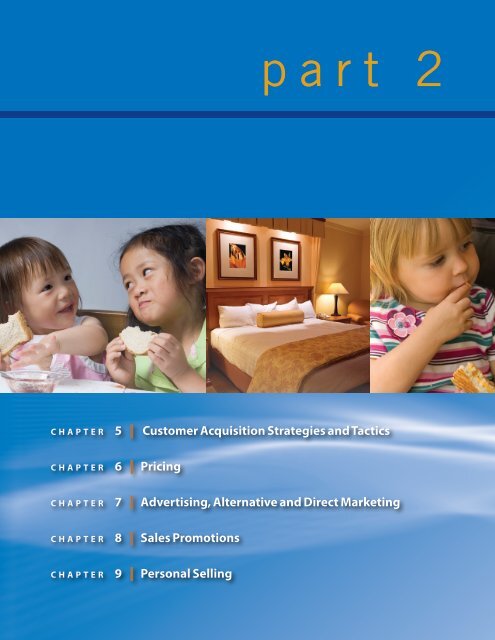chapter 5 Customer Acquisition Strategies and Tactics - Sage
chapter 5 Customer Acquisition Strategies and Tactics - Sage
chapter 5 Customer Acquisition Strategies and Tactics - Sage
Create successful ePaper yourself
Turn your PDF publications into a flip-book with our unique Google optimized e-Paper software.
part 2<br />
c h a p t e r 5<br />
<strong>Customer</strong> <strong>Acquisition</strong> <strong>Strategies</strong> <strong>and</strong> <strong>Tactics</strong><br />
c h a p t e r 6<br />
Pricing<br />
c h a p t e r 7<br />
Advertising, Alternative <strong>and</strong> Direct Marketing<br />
c h a p t e r 8<br />
Sales Promotions<br />
c h a p t e r 9<br />
Personal Selling
Managing <strong>Customer</strong><br />
<strong>Acquisition</strong>
How was Sony able to build a strong br<strong>and</strong> name<br />
<strong>and</strong> reputation?
5<br />
<strong>chapter</strong> 5<br />
<strong>Customer</strong> <strong>Acquisition</strong><br />
<strong>Strategies</strong> <strong>and</strong> <strong>Tactics</strong><br />
Sony: From Humble Beginnings to a<br />
Worldwide Br<strong>and</strong><br />
Today’s college students may not<br />
recall that, for many years, Japanese<br />
products were considered to be low-cost,<br />
inferior intrusions into the marketplace.<br />
“Made in Japan” became the punch line<br />
for a variety of jokes. It took many years<br />
<strong>and</strong> major changes in attitudes for<br />
American customers to trust <strong>and</strong> respect<br />
what are now powerful worldwide<br />
br<strong>and</strong>s. Among them, Sony has achieved<br />
a great deal of stature in the world of<br />
technology.<br />
In 1946, the Tokyo Tsushin Kogyo K.K., or<br />
Tokyo Telecommunications Engineering<br />
Corporation, was formed. The Japanese<br />
113
114<br />
part 2<br />
Managing <strong>Customer</strong> <strong>Acquisition</strong><br />
company, which was also known as Totsuko,<br />
began researching <strong>and</strong> manufacturing<br />
telecommunications <strong>and</strong> measuring<br />
equipment. Early success led to innovations in<br />
tape-recording equipment <strong>and</strong> in transistors,<br />
the cutting-edge technology of the time.<br />
Eventually in 1955, a new br<strong>and</strong> name,<br />
Sony, was assigned to Totsuko’s products,<br />
which included Japan’s first transistor radio.<br />
The company exp<strong>and</strong>ed its operations into<br />
the United States in 1960, at a time when<br />
Japanese goods were not viewed favorably.<br />
Still, new televisions, stereos, <strong>and</strong> tape<br />
recorders were added to the product line.<br />
Among the more noticeable innovations<br />
that led to respect for Sony’s products was<br />
the introduction of Trinitron technology,<br />
which added depth <strong>and</strong> quality to the<br />
company’s color television picture in<br />
1968. Sony became the first Japanese<br />
company to be awarded an Emmy Award<br />
for technological achievement for Trinitron.<br />
Two years earlier, the company had also<br />
begun producing <strong>and</strong> selling one of the first<br />
color video cassette players. At that point,<br />
Sony’s scope of operations reached Spain,<br />
France, <strong>and</strong> Germany, <strong>and</strong> soon after, Great<br />
Britain.<br />
Some of Sony’s product names remain part<br />
of the technology lingo of today. Betamax,<br />
the ½-inch-tape VCR product, was one of<br />
two major competing technologies in the<br />
late 1970s. In 1979, the “Walkman” was<br />
introduced. Three years later, the world’s first<br />
CD player reached the marketplace carrying<br />
the Sony br<strong>and</strong>.<br />
The Sony Corporation exp<strong>and</strong>ed into the<br />
music-recording industry as Sony Music<br />
Entertainment. The company moved into<br />
the life insurance marketplace through a<br />
coordinated effort with Prudential Insurance.<br />
Most of the corporation’s operations remain<br />
focused on technological innovations. The<br />
company was among the first competitors in<br />
the camcorder marketplace as well as highdefinition<br />
television (HDTV) design.<br />
A division of Sony opened in China in 1996.<br />
At the same time, the company exp<strong>and</strong>ed<br />
into digital technologies that are now<br />
commonplace. Flat-screen televisions soon<br />
followed.<br />
Today, Sony exists as a multinational<br />
corporation that continues to reinvent itself<br />
on a regular basis. The range of products<br />
now offered includes banking services,<br />
semiconductors, <strong>and</strong> numerous others.<br />
The power of the Sony br<strong>and</strong> rests on quality<br />
products, innovation, superior service,<br />
effective marketing communications,<br />
<strong>and</strong> successful management techniques.<br />
Changing consumer perceptions took time.<br />
At one point, the company’s advertising<br />
tagline was “Sony, No Baloney.” Such<br />
modesty is no longer necessary. What was<br />
once an unknown but innovative technology<br />
company is now a recognizable br<strong>and</strong> around<br />
the world. 1<br />
Chapter Overview<br />
The first part of this textbook was devoted to building a solid marketing foundation focused on<br />
developing a customer-oriented company. In Part 2, various methods of acquiring new customers<br />
are described. This <strong>chapter</strong> examines the nature of customer acquisition beginning with<br />
the distinction between existing products <strong>and</strong> new goods <strong>and</strong> services. Markets, products, <strong>and</strong><br />
br<strong>and</strong>s are examined with the goal of customer acquisition in mind.<br />
The remainder of Part 2 considers additional elements of customer acquisition.<br />
Chapter 6 addresses pricing. Chapter 7 reviews the role of advertising, including the use<br />
of nontraditional promotional programs. Chapter 8 examines the roles that consumer <strong>and</strong><br />
trade promotions play in developing a strong customer base. Chapter 9 analyzes personal<br />
selling tactics. Each of these ingredients is a vital part of a marketing management approach<br />
that emphasizes a customer orientation in the process of building a loyal base of consumers.
<strong>chapter</strong> 5 <strong>Customer</strong> <strong>Acquisition</strong> <strong>Strategies</strong> <strong>and</strong> <strong>Tactics</strong> 115<br />
From there, techniques to create positive<br />
interactions with them may be developed,<br />
<strong>and</strong> customer retention can be enhanced<br />
(see Figure 5.1).<br />
The first portion of this <strong>chapter</strong> provides a<br />
brief review of the product life cycle concept,<br />
focusing on the industry level. An analysis of<br />
the product life cycle reveals the importance<br />
of <strong>and</strong> difficulties associated with customer<br />
acquisition. Next, various approaches to customer<br />
acquisition are described, focusing on<br />
markets, products, <strong>and</strong> br<strong>and</strong>ing approaches.<br />
This <strong>chapter</strong> concludes with a review of the<br />
implications for customer service in developing<br />
quality customer acquisition programs.<br />
Marketing management foundation<br />
(Part 1)<br />
Managing customer retention<br />
(Part 4)<br />
Managing customer interaction<br />
(Part 3)<br />
Managing customer acquisition<br />
(Part 2)<br />
Figure 5.1 The Marketing Management Approach<br />
The Product Life Cycle<br />
The product life cycle models how sales of an item move over the lifetime of the item. A typical<br />
life cycle model consists of the introductory growth, maturity or saturation, <strong>and</strong> decline stages.<br />
Each presents new challenges for marketing managers.<br />
When a marketing expert considers the product life cycle, it is helpful to first think in macro<br />
terms, or an assessment of the entire industry. Figure 5.2 illustrates the typical life cycle of a<br />
product in an industry (the camera industry) in terms of total sales revenues <strong>and</strong> industry profits.<br />
A new product or innovation begins the introduction stage. In 1888, George Eastman created<br />
the first photographic film, <strong>and</strong> as a result, modern photography was born. In the 1890s,<br />
the first cameras were produced <strong>and</strong> sold by Eastman Kodak. Picture quality was poor <strong>and</strong><br />
dem<strong>and</strong> was low. Sales were limited to the few individuals willing to make purchases <strong>and</strong> those<br />
who knew how to operate the cameras. The early companies in the camera industry tended to<br />
experience losses, even though prices were high, as firms tried to recover development costs.<br />
The basic marketing goals during the introductory stage are to increase consumer awareness<br />
of the product, incite interest in the generic product, <strong>and</strong> encourage customers to make trial purchases.<br />
The more radically different a product, the more difficult <strong>and</strong> lengthy the introductory<br />
stage will be, because it takes time for many<br />
consumers to accept a change. Still, some customers<br />
may purchase the product because of<br />
its uniqueness. If is too similar to other products<br />
already on the market, then consumers<br />
will continue purchasing the former product<br />
rather than something new.<br />
In 1913, the 35-mm still camera was created.<br />
The flash bulb was introduced in 1935.<br />
Advances in technology continued, competition<br />
increased, <strong>and</strong> prices were driven down.<br />
At that point, many families could afford a<br />
camera. Cameras had entered the growth<br />
stage of the life cycle.<br />
During the growth stage, marketing managers<br />
emphasize differentiating the company’s<br />
Introduction Growth Maturity<br />
Time<br />
br<strong>and</strong> <strong>and</strong> highlighting the superiority of<br />
the br<strong>and</strong>. Marketing tactics tend to focus on<br />
building br<strong>and</strong> preference <strong>and</strong>, ultimately,<br />
br<strong>and</strong> loyalty. <strong>Customer</strong> acquisition becomes<br />
Sales<br />
Figure 5.2 The Product Life Cycle<br />
Profits<br />
Decline
116<br />
part 2<br />
Managing <strong>Customer</strong> <strong>Acquisition</strong><br />
Introduction<br />
Growth<br />
Figure 5.3 Extension of the Product Life Cycle<br />
How has the digital<br />
camera changed the<br />
photography industry?<br />
Maturity-Extension<br />
Time<br />
Decline<br />
increasingly important. The total market<br />
exp<strong>and</strong>s rapidly, which provides the opportunity<br />
for a company to capture market share by<br />
acquiring new customers. As a result, money<br />
is invested in a variety of customer acquisition<br />
methods.<br />
Next, market saturation or the maturity<br />
stage occurs. By the middle of the 20th century,<br />
most Americans owned one or more<br />
cameras. Sales <strong>and</strong> prices tend to level off<br />
in the maturity stage. Competition becomes<br />
intense, because in most cases too many companies<br />
have entered the industry with a version<br />
of the product. To grow, companies must<br />
take customers <strong>and</strong> sales away from competitors.<br />
Sales Profits<br />
To prevent a loss of market share, com-<br />
petitors often retaliate by using tactics such as<br />
cutting prices, offering coupons, or developing<br />
unique versions of the product that appeal<br />
to smaller, individual market segments. As the<br />
maturity stage continues, some companies are<br />
shaken out, or go out of business. The remaining competitors tend to find the equilibrium in<br />
which prices <strong>and</strong> marketing programs start to stabilize.<br />
During the maturity stage, managers of the marketing department focus on long-term strategies<br />
for the company, including an emphasis on research <strong>and</strong> development to create product<br />
improvements or completely new products. <strong>Tactics</strong> used during the maturity stage include finding<br />
ways to maintain a competitive edge. Since there is no influx of new buyers into the market,<br />
the focus shifts to existing markets or to modifying the current product to meet the needs of<br />
specific target markets.<br />
Most products today are in the maturity stage of the life cycle, which means intense competition<br />
exits. To survive, a company must continually modify its marketing approach to meet<br />
changes in competitor tactics <strong>and</strong> changes in consumer preferences. Company leaders also look<br />
for new products or modifications of current products in order to extend the life cycle or create<br />
a mini burst in the maturity stage of the life cycle. Figure 5.3 illustrates this process. In the camera<br />
industry, it took place when Kodak started marketing Kodachrome film in 1935. The maturity<br />
stage continues until a substitute product is invented or consumer tastes change. Cameras<br />
that use film remained in the maturity stage until digital cameras were invented.<br />
The first digital camera was introduced in 1981 by Sony for the<br />
commercial market, because the price was too high for consumers.<br />
Then in 1991, Kodak took the technology one step further <strong>and</strong> developed<br />
a digital camera for photography professionals <strong>and</strong> journalists.<br />
As competitors entered the digital camera market with new versions,<br />
prices quickly declined until consumers could afford the new format.<br />
When this occurred, the film camera industry moved into the<br />
decline stage. Seeing the advantages of digital cameras, consumers are<br />
quickly changing over, <strong>and</strong> the dem<strong>and</strong> for film cameras is plummeting.<br />
This change in the market, in turn, causes leaders of marketing<br />
departments to revise the company’s strategies <strong>and</strong> tactics to address<br />
the change from film cameras to digital cameras. The introduction <strong>and</strong><br />
growth stages for digital cameras occurred more quickly because consumers<br />
were already familiar with cameras <strong>and</strong> photography.<br />
The characteristics of each stage of the product life cycle are<br />
unique. Therefore, the marketing strategies companies use will also<br />
change. Table 5.1 provides greater detail about the characteristics<br />
<strong>and</strong> marketing strategies used in each stage of the life cycle.
<strong>chapter</strong> 5 <strong>Customer</strong> <strong>Acquisition</strong> <strong>Strategies</strong> <strong>and</strong> <strong>Tactics</strong> 117<br />
Stage of PLC Characteristics Marketing <strong>Strategies</strong><br />
Introduction 1. Market is small. 1. Build primary dem<strong>and</strong> for the product.<br />
2. Growth rate is slow. 2. Establish a distribution channel.<br />
3. Often only the company is the pioneer.<br />
4. Companies experience losses.<br />
Growth 1. Market grows rapidly. 1. Differentiate the br<strong>and</strong>.<br />
2. Competitors enter the market. 2. Promote competitive advantage or product differentiation.<br />
3. Profits are high. 3. Build distribution channel.<br />
Maturity 1. Growth slows <strong>and</strong> then flattens. 1. Segment market <strong>and</strong> focus on one or more segments.<br />
2. Competition is most intense. 2. Promote br<strong>and</strong> <strong>and</strong> product differentiation.<br />
3. Profits decline. 3. Focus on customer service, customer<br />
4. Some firms drop out due to competition. satisfaction, <strong>and</strong> customer retention.<br />
5. Price becomes more important. 4. Exp<strong>and</strong> product or market opportunities.<br />
6. Large amounts are spent on marketing.<br />
Decline 1. Market declines. 1. Decide whether to leave market or be a niche player.<br />
2. Profits decline. 2. Promote the niche to those who still want the product.<br />
3. Substitute product is found.<br />
Table 5.1<br />
Characteristics of <strong>and</strong> Marketing <strong>Tactics</strong> for the Product Life Cycle (PLC)<br />
The Importance of <strong>Customer</strong> <strong>Acquisition</strong><br />
As noted, many firms operate in the intensely competitive environment of the maturity stage<br />
of the life cycle. In that stage, the marketing team knows that in order to maintain current sales<br />
levels, new customers are needed to replace those who are lost or who have migrated to competing<br />
firms. The team can never reach the point where they can relax, believing the company<br />
has enough customers. Consequently, companies face a continuing struggle on two fronts:<br />
(1) keeping current customers <strong>and</strong> (2) finding new customers.<br />
The number of new customers required to maintain the status quo or to grow depends on<br />
how well a firm retains its current customers. A firm that loses 5% of its customers every year<br />
needs to gain at least that many new ones during the year. It is clear that long-term marketing<br />
success is based, in part, on acquiring new customers. To do so, a progression of marketing<br />
goals must be met, starting with making consumers aware that a company or br<strong>and</strong> exists. Next,<br />
potential customers must be moved from awareness to more positive emotions, such as liking<br />
<strong>and</strong> preference, <strong>and</strong> eventually to the point of making the purchase. Then, postpurchase feelings<br />
are addressed, including offering reassurance <strong>and</strong> support by suggesting that the customer<br />
has made a wise choice <strong>and</strong> should consider repeating that choice in the future.<br />
Acquiring new customers is difficult in the maturity stage of the product life cycle because<br />
each of the firm’s competitors also tries to acquire new customers. When industry sales have<br />
stabilized, a firm acquires a new customer by enticing that person away from a competitor. In<br />
general, there are three basic forms of customer acquisition:<br />
1. Developing existing or new markets<br />
2. Developing existing or new products<br />
3. Br<strong>and</strong>ing
118<br />
part 2<br />
Managing <strong>Customer</strong> <strong>Acquisition</strong><br />
At the same time, when developing marketing programs to acquire new customers, marketing<br />
managers should not lose sight of ways to retain current customers. The temptation exists to<br />
spend more time <strong>and</strong> money on acquiring new customers as current customers drift away. Such<br />
an approach ultimately creates problems for the company. Fortunately, many of the methods<br />
used to acquire customers may also help to keep them.<br />
<strong>Customer</strong> <strong>Acquisition</strong>: Identifying Markets<br />
• Existing markets<br />
– Br<strong>and</strong> switching<br />
– New needs<br />
– Product<br />
differentiation<br />
• New markets<br />
– Discover or create<br />
new segments<br />
– Adapt current<br />
products<br />
– Geographic<br />
expansion<br />
• Domestic<br />
• International<br />
Figure 5.4<br />
<strong>Customer</strong> <strong>Acquisition</strong><br />
<strong>Strategies</strong>: Markets<br />
Marketing managers seeking to acquire new customers through identifying new markets<br />
can examine two primary areas: (1) existing markets <strong>and</strong> (2) potential new markets (see<br />
Figure 5.4). The goal is to find customer segments that can be approached through various<br />
marketing programs.<br />
Existing Markets<br />
Many times, new customers are located in existing markets. Any industry, from products such as<br />
clothes, medicines, <strong>and</strong> automobiles to services such as travel, life insurance, <strong>and</strong> banking, contains<br />
segments of individuals who may be enticed to change br<strong>and</strong>s or who have not purchased<br />
the product for the first time yet. One approach to customer acquisition is to focus on br<strong>and</strong><br />
switching within existing market segments. Thus, a consumer in the yogurt-as-health-food segment<br />
may be enticed to move from Dannon to Yoplait because one offers different features,<br />
ingredients, or taste as compared with the other.<br />
Also, there are times when customers may be discovered because new needs arise in existing<br />
markets, due primarily to changing situations or cultural trends. For example, in 2009, all television<br />
stations in the United States moved from analog transmission to digital signals, known as<br />
HDTV. The existing market, television set owners, had fragmented into those owning old analog<br />
sets, those who purchased analog sets with the ability to receive an HD signal, <strong>and</strong> customers<br />
owning HDTV receivers. One market segment, owners of analog-only televisions, created a market<br />
opportunity for companies to produce <strong>and</strong> sell the adapters needed to translate the HD signal<br />
into an analog format. A similar situation emerged when the city of New York passed an ordinance<br />
outlawing the use of trans-fats in food preparation in any restaurant in the city.<br />
A third approach is to create the perception that an existing product or br<strong>and</strong> is different <strong>and</strong><br />
better, which is product differentiation. Br<strong>and</strong> equity <strong>and</strong> product differentiation are closely<br />
related. In both instances, the difference can be real or created in the consumer’s mind through<br />
various marketing practices.<br />
New Markets<br />
New markets are discovered using a variety of tactics. Products may be used in new ways, new<br />
markets may be created, or a market may exp<strong>and</strong> or evolve on its own. One common customer<br />
acquisition approach is to discover or create new segments based on changing needs. The past<br />
contains several examples. In personal grooming, past generations of males went to barber<br />
shops <strong>and</strong> females visited beauty salons. Currently, both genders go to style salons <strong>and</strong> receive<br />
more than just hair care. Many also offer manicures <strong>and</strong> pedicures along with other services.<br />
One group of physicians has exp<strong>and</strong>ed from traditional doctor’s office formats to spa-based<br />
cosmetology, massage therapy, <strong>and</strong> other forms of care that may or may not be considered<br />
medically necessary. Avon’s Skin So Soft lotion has evolved into an insect repellant product as<br />
well, thereby reaching a much wider <strong>and</strong> dramatically different market (think of hunters <strong>and</strong><br />
fishermen).<br />
Finding new market segments may be the result of creatively adapting products to new<br />
markets by thinking about what a good or service has to offer. Thus, the traditional segments of<br />
demographics, psychographics, geographic areas, product usage, user type, <strong>and</strong> others should<br />
continually be reexamined to see if a new group can be reached by creating a new product,
<strong>chapter</strong> 5 <strong>Customer</strong> <strong>Acquisition</strong> <strong>Strategies</strong> <strong>and</strong> <strong>Tactics</strong> 119<br />
modifying an existing product, or changing the ways in which an<br />
existing product is marketed.<br />
Not all these efforts to find, define, or redefine existing <strong>and</strong><br />
new markets are the result of strategic decisions made by top managers.<br />
In more than one instance, a first-level employee had made<br />
a suggestion that was passed along to a supervisor, <strong>and</strong> eventually<br />
the idea was implemented. The Starbucks top management team<br />
actively solicits ideas from baristas <strong>and</strong> even customers. Several<br />
items sold at Starbucks were introduced based on suggestions from<br />
these sources. Entry-level employees often believe that discovering<br />
such innovations may be a pathway to quicker promotion <strong>and</strong>/or a<br />
bigger pay raise.<br />
Geographic Expansion: Domestic Markets<br />
Geographic expansion can take place through domestic expansion<br />
or by seeking out international markets. <strong>Customer</strong>s may be<br />
acquired by exp<strong>and</strong>ing to a geographic area in which a good or<br />
service is not offered or where a particular br<strong>and</strong> is not being sold.<br />
Geographic expansion often creates a new set of obstacles, such<br />
as having to increase the number of units, offices, <strong>and</strong> employees.<br />
These become more complicated in any international program.<br />
Many companies find the best route to growth is simply by adding<br />
new locations or finding new geographic markets to enter. This<br />
can be done by entering a new territory. There was a time in which<br />
Coors beer was only sold in Kansas, Colorado, <strong>and</strong> California. Part<br />
of the success achieved by the company resulted from entering<br />
other states.<br />
Many times, a product has a regional base, which offers the possibility<br />
of moving into nearby territories. Other times, a firm many<br />
identify geographic areas with specific characteristics. For example,<br />
the Costco chain added locations in major metropolitan areas. The<br />
same was true for many years in the Krispy Kreme company.<br />
One common strategy used for domestic expansion is franchising.<br />
The dramatic growth of many fast-food chains, including<br />
McDonald’s <strong>and</strong> SUBWAY, is based on selling franchises in new<br />
locations.<br />
Geographic Expansion: International Markets<br />
As has been noted, many company leaders, even in small firms, view a firm’s marketplace as<br />
the entire globe. Assisted by new technologies <strong>and</strong> more sophisticated delivery systems, smaller<br />
companies can identify customers <strong>and</strong> sell products around the world.<br />
The st<strong>and</strong>ard methods for entering international markets begin with simple exporting but<br />
also include the other modes of entry shown in Figure 5.5. The problems associated with entering<br />
foreign markets are as well documented as the potential benefits. Company leaders carefully<br />
consider not only the method to be used in exp<strong>and</strong>ing but also how the various obstacles may<br />
be overcome.<br />
In the summer of 2008, the Oreo cookie was being marketed for the first time in Great<br />
Britain. Many of the logistical issues were quickly <strong>and</strong> easily resolved. Culturally speaking, the<br />
challenge was much larger. It turns out that many British citizens are fiercely loyal to their “biscuits.”<br />
Changing minds <strong>and</strong> attitudes toward an “American” product may prove to be difficult. 2<br />
Market research plays a key role in international expansion. Company leaders should be<br />
able to present solid evidence that expansion will succeed before attempting to export goods or<br />
beginning operations in a new country.<br />
Past generations<br />
of males used<br />
barbershops for<br />
haircuts; in recent years,<br />
beauty shops have<br />
targeted services to both<br />
genders.
120<br />
part 2<br />
Managing <strong>Customer</strong> <strong>Acquisition</strong><br />
• Indirect exporting One company h<strong>and</strong>les exported goods for another company.<br />
• Direct exporting<br />
A company exports it own goods <strong>and</strong> services.<br />
• Turnkey project<br />
A company designs, builds, <strong>and</strong> starts up a business in another<br />
country <strong>and</strong> then sells the operation to a local client company.<br />
• Licensing<br />
A company transfers the rights <strong>and</strong> grants permission to<br />
produce <strong>and</strong> sell its products overseas to a foreign firm.<br />
• Franchising<br />
The license to sell applies only to a single good or service or to a<br />
single unit of operation.<br />
• Joint venture<br />
Two companies work together making <strong>and</strong> selling a product or<br />
operation.<br />
• Strategic alliance Cooperative agreements between potential competitors in a<br />
foreign country.<br />
• Wholly owned subsidiary A multinational corporation owns a company in another country.<br />
Figure 5.5 Modes of Entry<br />
• Product development<br />
– Development<br />
– Diversification<br />
• Product improvements<br />
– Based on customer<br />
needs<br />
– Based on<br />
technology<br />
• Product line<br />
extensions<br />
Figure 5.6<br />
<strong>Customer</strong> <strong>Acquisition</strong><br />
<strong>Strategies</strong>: Products<br />
<strong>Customer</strong> <strong>Acquisition</strong>: Developing Products<br />
<strong>Acquisition</strong> of new customers often results from the implementation of a product strategy.<br />
Products attract new customers by offering new features, eliminating old problems, <strong>and</strong> solving<br />
different needs. The three most common product development strategies are displayed in<br />
Figure 5.6. Products are only developed when they can be matched with a viable market segment<br />
or when they can be differentiated from competing br<strong>and</strong>s in the marketplace.<br />
Product Development<br />
Product development is a marketing strategy in which new goods <strong>and</strong> services are developed<br />
<strong>and</strong> then added to current lines <strong>and</strong> marketed to existing customers. Product diversification<br />
occurs when new goods <strong>and</strong> services are created for new market segments not currently being<br />
served by the company. Many firms spend large sums of money developing new products.<br />
When company leaders believe a viable market exists that can be tapped by offering a completely<br />
new product, funds will be authorized to turn the idea into a reality.<br />
Before beginning the physical development of an item, various forms of testing take place.<br />
One of the more common is the use of focus groups. A focus group consists of a set of individuals<br />
who are prompted to discuss an item or topic. In 2007, Amazon.com began to offer a new<br />
product, the Kindle, which is a method of carrying a series of books <strong>and</strong> other reading materials<br />
in a portable device that offers a variety of features, including a dictionary that can be accessed<br />
while reading something else <strong>and</strong> the ability to load books, magazine articles, <strong>and</strong> even blogs<br />
from any location. In the past, focus groups had pointed out the problems with other methods<br />
of downloading books. The Kindle was developed to solve those problems. 3<br />
Cultural trends <strong>and</strong> other changes may also lead to development <strong>and</strong> diversification strategies.<br />
McDonald’s added products such as fruit cups, yogurt, <strong>and</strong> salads to its st<strong>and</strong>ard menu.<br />
The products were developed to entice more health-conscious customers into the restaurant.<br />
Pizza Hut added several pasta products to its menu in an attempt to widen its customer base.<br />
The strategy of developing a new product only succeeds through proper implementation.<br />
The product <strong>and</strong> its advantages must first be understood by internal employees. Then, these<br />
employees should be motivated to emphasize the new item to existing customers <strong>and</strong> potential<br />
new customers. The role of the first-line supervisor is to follow through <strong>and</strong> be certain that those<br />
at the entry level support the new product.
<strong>chapter</strong> 5 <strong>Customer</strong> <strong>Acquisition</strong> <strong>Strategies</strong> <strong>and</strong> <strong>Tactics</strong> 121<br />
Product Improvements<br />
Products are often improved in order to solve small, specific problems based on customer<br />
needs. For example, st<strong>and</strong>ard luggage in the past century was often quite large <strong>and</strong> only had a<br />
h<strong>and</strong>le to be used for carrying the suitcase. One product improvement resulted from the frustrations<br />
many passengers had with baggage h<strong>and</strong>lers, <strong>and</strong> the carry-on bag was developed. A<br />
second product improvement emerged when the concept of adding rollers to the suitcase was<br />
developed.<br />
Products may also be improved when new technologies become available. Battery technology,<br />
for example, has evolved a great deal over the years. Alkaline-based batteries are now only<br />
one form. Competition comes from both nickel metal hydride <strong>and</strong> lithium batteries.<br />
Product improvements often are marketed as the “better mousetrap.” The advantages of the<br />
improvement become the key selling point. The improvements should match the needs of a<br />
viable market segment or create br<strong>and</strong> equity in the total market.<br />
It is important to explain the advantages of a new version of a product to everyone in the<br />
company. Those holding first-line positions will be the ones to explain these features to potential<br />
customers. Supervisors should be able to reward those who make the effort to pass the<br />
information on to the public.<br />
Product Line Extensions<br />
<strong>Customer</strong>s can be acquired through product line extensions. Many food <strong>and</strong> beverage producers<br />
use product line extension tactics. Recently, Bud Light was extended to include a Bud Light<br />
Lime product. Campbell’s Soups added a series of lower-sodium “sea salt” products. The producers<br />
of Kool-Aid constantly add (<strong>and</strong> delete) versions of the product, as do the makers of<br />
Lipton Tea (caffeine-free, sweetened, unsweetened, lemon flavored, raspberry flavored, <strong>and</strong><br />
peach flavored).<br />
Extending product lines often involves customizing products to more specific tastes <strong>and</strong><br />
individual preferences. In the eyeglass industry, some customers prefer tinted lenses while others<br />
want clear lenses. Extending product lines increases the chances that a set of customers will<br />
switch br<strong>and</strong>s, because the new version more closely meets their needs.<br />
In summary, the definition of marketing offered in Chapter 1 suggested that it is “discovering<br />
consumer wants <strong>and</strong> needs, creating the products <strong>and</strong> services that meet those needs, pricing,<br />
promoting, <strong>and</strong> delivering the products <strong>and</strong> services.” One clear route to acquiring new customers<br />
is creating or adapting products that meet the needs of a set of consumers.<br />
STOP AND THINK ______________________________________<br />
Consider this statement:<br />
Nearly 40,000 new products are brought to the marketplace each year. Most fail to survive.<br />
Using the information you have read thus far, answer the following questions:<br />
1. What market-based factors might explain this failure rate?<br />
2. What product-based factors might explain this failure rate?<br />
3. What market-based factors explain why one product succeeds while others fail?<br />
4. What product-based factors might explain why one item succeeds <strong>and</strong> others fail?<br />
5. Explain the connections between products <strong>and</strong> markets that explain success <strong>and</strong><br />
failure.<br />
6. Is it harder to create <strong>and</strong> sell a new good or a new service? Why?
122<br />
part 2<br />
Managing <strong>Customer</strong> <strong>Acquisition</strong><br />
Br<strong>and</strong>ing<br />
How have Gillette <strong>and</strong><br />
Schick developed strong<br />
br<strong>and</strong> names?<br />
In the world of marketing management, creating a powerful<br />
br<strong>and</strong> has emerged as a key ingredient in the longterm<br />
success of a company. When a woman decides<br />
she needs a new perfume, one of her first thoughts is<br />
probably about the names of different perfumes she<br />
knows or has heard about. When a man thinks about<br />
buying cologne, various names probably may come<br />
to mind. In both instances, the name is the product’s<br />
br<strong>and</strong>, whether it is for a specific item such as Cool<br />
Water, L’air du Temps, or Polo or a house name, such as<br />
Ralph Lauren, Yves Saint Laurent, or Paul Sebastian.<br />
Strong br<strong>and</strong>s can contribute to customer acquisition.<br />
For example, as a young man begins to discover<br />
the need to shave, he is likely to first consider wellknown<br />
br<strong>and</strong>s, such as Gillette or Schick. Major br<strong>and</strong>s<br />
have the benefit of being the first considered for new<br />
shoppers as well as those who are in new situations.<br />
For instance, someone traveling in Europe for the first time may be enticed to stay at the Holiday<br />
Inn simply because the consumer remembers the br<strong>and</strong> name.<br />
Types of Br<strong>and</strong>s<br />
Br<strong>and</strong>s are assigned to individual products, such as an iPod; to lines of products, including<br />
all the Green Giant vegetables <strong>and</strong> juices; to companies offering products (Golden Corral,<br />
SUBWAY); to individual services; <strong>and</strong> to companies that offer services. MasterCuts is a br<strong>and</strong><br />
assigned to a hairstyling service. The name MasterCard applies to both the service, a credit card,<br />
<strong>and</strong> to the company that offers the service. Visa uses the same name to identify the corporation<br />
<strong>and</strong> individual services such as the Visa Check Card.<br />
There are several ways in which names <strong>and</strong> br<strong>and</strong>s appear. The term used to identify an<br />
entire company is the corporate name, which may or may not be a br<strong>and</strong>. Procter & Gamble<br />
(P&G) is a corporate name that is not assigned to any product. The corporate name Campbell’s<br />
is added to every product the company offers. In that situation, the name Campbell’s is considered<br />
to be a house mark form of br<strong>and</strong>. A br<strong>and</strong> is the name given to a product <strong>and</strong>, in some<br />
instances, to the company. The primary forms of br<strong>and</strong>s include<br />
• family br<strong>and</strong>s,<br />
• flanker br<strong>and</strong>s,<br />
• br<strong>and</strong> extensions,<br />
• private br<strong>and</strong>s (or private labels),<br />
• cobr<strong>and</strong>s, <strong>and</strong><br />
• global br<strong>and</strong>s.<br />
Family Br<strong>and</strong>s<br />
A family br<strong>and</strong> is the name used when a company offers a series or group of products under one<br />
br<strong>and</strong>. For instance, the Black & Decker br<strong>and</strong> is used for a series of power tools. It is very similar<br />
to a house mark. The difference is that one company may feature several family br<strong>and</strong>s. For<br />
instance, the Masco Corporation sells faucet <strong>and</strong> plumbing supplies using three family br<strong>and</strong>s—<br />
Delta, Peerless, <strong>and</strong> Brizo.
<strong>chapter</strong> 5 <strong>Customer</strong> <strong>Acquisition</strong> <strong>Strategies</strong> <strong>and</strong> <strong>Tactics</strong> 123<br />
The primary advantage of a family br<strong>and</strong> is that consumers usually<br />
transfer the image associated with the br<strong>and</strong> name to any new products<br />
added to current lines. When Black & Decker offers a new power tool,<br />
the new item automatically carries the reputation associated with the<br />
Black & Decker name. These transfer associations occur as long as the<br />
new product remains in the same product category. When additional<br />
products are not related to the br<strong>and</strong>’s core merch<strong>and</strong>ise, the transfer of<br />
loyalty may not occur as easily.<br />
Flanker Br<strong>and</strong>s<br />
A flanker br<strong>and</strong> is the development of a new br<strong>and</strong> by a company in a<br />
good or service category in which the company currently has a br<strong>and</strong><br />
offering. Flanker br<strong>and</strong>s may be used to exp<strong>and</strong> a portfolio of products<br />
by adding higher- or lower-priced versions or versions aimed at particular<br />
markets. They are also featured when concerns arise that using the<br />
family br<strong>and</strong> name will confuse consumers <strong>and</strong> dilute the br<strong>and</strong> equity<br />
that has developed over the years.<br />
Procter & Gamble’s primary laundry detergent br<strong>and</strong> names are<br />
Cheer <strong>and</strong> Tide. Over the years, additional flanker br<strong>and</strong>s, such as Ivory<br />
Snow were introduced. In total, Procter & Gamble offers 11 different<br />
br<strong>and</strong>s of detergents in North America; 16 in Latin America; 12 in Asia;<br />
<strong>and</strong> 17 in Europe, the Middle East, <strong>and</strong> Africa. The company’s marketing<br />
team introduced these flanker br<strong>and</strong>s to appeal to target markets<br />
that they believed its main br<strong>and</strong> was not reaching.<br />
Sometimes a flanker br<strong>and</strong> is introduced when company leaders<br />
conclude that offering the product under the current br<strong>and</strong> name<br />
will adversely affect the overall marketing program. Hallmark created a<br />
flanker br<strong>and</strong> known as Shoebox Greetings. The cards sell in discount<br />
stores as well as Hallmark outlets; however, the Hallmark br<strong>and</strong> sells<br />
only in its named retail stores. Shoebox Greetings cards are lower priced<br />
<strong>and</strong> allow Hallmark to attract a larger percentage of the market. Firms<br />
often use this type of strategy in high-end markets that want to compete<br />
in low-end markets. Doing so makes it possible to acquire a new set of<br />
customers for the company.<br />
Flanker br<strong>and</strong>s may also be part of an international operation. As noted, Procter & Gamble<br />
sells Ariel laundry detergent in Latin America, Asia, Europe, the Middle East, <strong>and</strong> Africa but not<br />
in North America. Offering different br<strong>and</strong>s for specific markets continues to be a common<br />
flanker br<strong>and</strong> strategy in international markets.<br />
Challenges of Br<strong>and</strong> Extensions <strong>and</strong> Multiple Br<strong>and</strong>s<br />
A br<strong>and</strong> extension is the use of the firm’s current br<strong>and</strong> name on new products <strong>and</strong> new versions<br />
of current products. Due to its complexity, managing br<strong>and</strong> extensions <strong>and</strong> multiple<br />
br<strong>and</strong>s is one of the most challenging tasks facing the marketing manager. Successful br<strong>and</strong>s<br />
continuously evolve to meet the changing needs of a diverse marketplace.<br />
Black & Decker’s strong<br />
br<strong>and</strong> name allows the<br />
company’s marketing<br />
team to introduce<br />
new products with<br />
immediate br<strong>and</strong> equity.<br />
Cannibalization<br />
While multiple br<strong>and</strong>s <strong>and</strong> br<strong>and</strong> extensions provide benefits as already mentioned, they can<br />
also create problems. The first is cannibalization. When a new product’s sales take away from<br />
sales of the rest of the company’s line, the new product does not contribute significantly to<br />
income or company profit.<br />
To ensure that cannibalization does not occur, the target market for the new product or br<strong>and</strong><br />
must be clearly different from the target market for current br<strong>and</strong>s. The goal is to gain market<br />
share from competitors <strong>and</strong> new customers, not by diluting sales of current br<strong>and</strong>s. Recently Jeep
124<br />
part 2<br />
Managing <strong>Customer</strong> <strong>Acquisition</strong><br />
Quarterly Sales ($)<br />
Change in Sales<br />
1st Quarter 2nd Quarter Dollars Percent<br />
Total of all oatmeal products 734,207 755,213 21,006 2.86<br />
Sales of new oatmeal flavor 112,528<br />
Sales of oatmeal Flavor A 324,675 327,549 2,874 0.89<br />
Sales of oatmeal Flavor B 123,763 96,543 −27,220 −21.99<br />
Sales of oatmeal Flavor C 285,769 218,593 −67,176 −23.51<br />
Measuring Change Percent<br />
cannibalization effect in Sales ($) Sales<br />
Sales of new oatmeal flavor 112,528<br />
Sales of oatmeal Flavor B −27,220 24.19<br />
Sales of oatmeal Flavor C −67,176 59.70<br />
New sales generated by new flavor 18,132 16.11<br />
Table 5.2<br />
Cannibalization Effects<br />
• Lighter manufacturer<br />
Bic spent $20 million<br />
to launch a line of<br />
perfume.<br />
• Pond’s, a face cream<br />
manufacturer,<br />
launched a<br />
toothpaste.<br />
• Levi’s in the 1980s<br />
introduced tailored<br />
suits.<br />
• Victoria’s Secret<br />
launched a new line<br />
of athletic wear.<br />
Figure 5.7<br />
Question able Br<strong>and</strong><br />
Extensions<br />
introduced four additional models to accompany current lines. For years, Jeep only sold three<br />
models. Now there are seven. Jeep’s marketing team defended the br<strong>and</strong> extension, stating that<br />
the new models appeal to different target markets. If they do, Jeep has succeeded with the extension.<br />
If they cannibalize sales of current models, then it will have been a mistake. 4<br />
A simplified example of the cannibalization effect is illustrated in Table 5.2. The first-quarter<br />
sales of a company that offers three flavors of breakfast oatmeal is $734,207. A new flavor was<br />
introduced that generated sales of $112,528 for the second quarter. An examination of sales for<br />
the company <strong>and</strong> for individual flavors indicates a serious problem of cannibalization. Although<br />
revenues for the new flavor were over $112,000, the company only experienced a sales increase<br />
of 2.8%, or $21,006. Only 16.11% of the sales of the new flavor came from new customers trying<br />
the flavor, or perhaps from individuals who would have purchased Flavor A. Sales of Flavor<br />
A did increase, which means it is unlikely that there was much of a cannibalization effect. The<br />
decline in purchases of Flavors B <strong>and</strong> C indicates that most of the individuals who tried the new<br />
flavor switched from these two flavors to the new one. Almost 60% of the sales of the new br<strong>and</strong><br />
came from decline in the sales of Flavor C, <strong>and</strong> almost 24% of the income resulted from individuals<br />
who switched from Flavor B.<br />
A Poor Fit<br />
The second possible obstacle to an effective expansion occurs when a company moves into<br />
product categories that are not a good match. While sales may not cannibalize current products,<br />
the failure of the new product br<strong>and</strong> can damage the company’s reputation <strong>and</strong> possibly<br />
adversely affect the br<strong>and</strong> equity associated with current products. Figure 5.7 highlights some<br />
of the br<strong>and</strong> extensions that have not achieved a great deal of success. Most of these companies<br />
entered markets that did not align well with the original core business. Therefore, when considering<br />
br<strong>and</strong> extensions, it is helpful to assess the impact the new br<strong>and</strong> will have on the company’s<br />
current image <strong>and</strong> products currently on the market.<br />
Private Br<strong>and</strong>s<br />
Closely related to br<strong>and</strong> extensions are private br<strong>and</strong>s or private labels. In the past<br />
decade, private label br<strong>and</strong>s have become increasingly popular. The trend resulted<br />
from changing consumer views of private labels. Where they were once viewed
<strong>chapter</strong> 5 <strong>Customer</strong> <strong>Acquisition</strong> <strong>Strategies</strong> <strong>and</strong> <strong>Tactics</strong> 125<br />
as being low-cost, low-quality alternatives, many now believe quality<br />
levels are similar to manufacturers’ br<strong>and</strong>s.<br />
In addition, the methods retailers use to market <strong>and</strong> display private<br />
br<strong>and</strong>s in retail stores lead to a situation in which many consumers do<br />
not know if they are purchasing a private label br<strong>and</strong> or a manufacturer’s<br />
br<strong>and</strong>. For instance, 45% of JCPenney’s clothing revenue comes from its<br />
private labels such as Arizona Jeans, a.n.a., <strong>and</strong> American Living. The<br />
American Living br<strong>and</strong> was recently created by Ralph Lauren <strong>and</strong> added<br />
as a higher-end fashion line priced slightly higher than some national<br />
br<strong>and</strong>s. 5 Wal-Mart offers eight different private br<strong>and</strong>s of clothing, such<br />
as No Boundaries, Simply Basic, Metro 7, <strong>and</strong> Kid Connection. Unless<br />
consumers are knowledgeable about specific br<strong>and</strong>s, many times they<br />
do not know if it is a private label or a manufacturer’s br<strong>and</strong>.<br />
The rise in the sales of private labels has led to many manufacturers<br />
producing private label br<strong>and</strong>s in addition to the firm’s primary<br />
br<strong>and</strong>s. Others may consider this type of approach. Producing private<br />
label merch<strong>and</strong>ise becomes viable when the manufacturer has excess<br />
plant capacity <strong>and</strong> a significant increase in sales of its br<strong>and</strong> does not<br />
seem likely. The manufacturer’s management team also considers<br />
whether producing a private label might damage the reputation or hurt<br />
the sales of the company’s br<strong>and</strong>. These issues were undoubtedly considered<br />
by Whirlpool’s leaders when the company began to manufacture<br />
the Kenmore br<strong>and</strong> of appliances for Sears. Private labeling allows<br />
a manufacturer to increase sales without inviting the complications <strong>and</strong><br />
marketing costs of flanker br<strong>and</strong>ing.<br />
Retail marketing managers consider the private label option when<br />
the power of the store’s name can be extended to individual products<br />
or when the store has a large customer base that is not highly<br />
loyal to manufacturers’ br<strong>and</strong>s. This allows alternative br<strong>and</strong>s to be<br />
offered alongside manufacturers’ br<strong>and</strong>s, thereby increasing consumer<br />
choices. It also allows the retailer to earn larger margins on store<br />
br<strong>and</strong>s. The presence of additional choices may be what it takes to<br />
exp<strong>and</strong> a retail store’s customer base by attracting new customers.<br />
Private labels tend to experience higher sales during recessionary<br />
periods. <strong>Customer</strong>s seeking lower-priced options may turn to them, both<br />
in big box stores such as Wal-Mart as well as in higher-end retail outlets.<br />
Cobr<strong>and</strong>ing <strong>and</strong> Ingredient Br<strong>and</strong>ing<br />
For some producers, cobr<strong>and</strong>ing <strong>and</strong> ingredient br<strong>and</strong>ing are vital elements in the company’s<br />
marketing program. Cobr<strong>and</strong>ing occurs when two firms work together to market a good or service.<br />
Any credit card that carries both the card name (Discover, MasterCard) <strong>and</strong> another company’s<br />
name (American Airlines, Sears) is part of a cobr<strong>and</strong>ing program. Ingredient br<strong>and</strong>ing takes<br />
place when a product is featured as a key ingredient or component of another product. A simple<br />
example is NutraSweet, which is used in over 5,000 products <strong>and</strong> is featured on many of the labels<br />
of those products. The Dolby sound system is another example of an ingredient br<strong>and</strong>.<br />
The goal for both cobr<strong>and</strong>ing <strong>and</strong> ingredient br<strong>and</strong>ing is to take advantage of the two<br />
br<strong>and</strong>s in order to reach a wider audience. Both programs allow for cooperative advertising,<br />
sharing data files regarding customers, <strong>and</strong> cross-selling of additional products once a purchase<br />
has been made. The stronger the power of the two br<strong>and</strong>s, the more likely it becomes that these<br />
strategies will attract new customers.<br />
Cobr<strong>and</strong>ing becomes a disadvantage when one br<strong>and</strong> in the relationship endures negative<br />
publicity or some other br<strong>and</strong>- or image-damaging event. The power of the NutraSweet br<strong>and</strong><br />
may have been diminished in the past few years when some raised concerns about the possibility<br />
of injury to consumers’ health. If so, there may be carryover effects to products containing<br />
the ingredient, even when the concerns are not legitimate.<br />
What caused the rise<br />
in the sales of private<br />
labels?
126<br />
part 2<br />
Managing <strong>Customer</strong> <strong>Acquisition</strong><br />
• Br<strong>and</strong> continuously<br />
delivers benefits<br />
that meet or exceed<br />
expectations<br />
• Ongoing relevance<br />
to defined<br />
audiences<br />
• Price captures<br />
customers’<br />
perception of value<br />
• Flexibility in<br />
communication with<br />
consistency<br />
• Employees<br />
underst<strong>and</strong> br<strong>and</strong><br />
promise<br />
• Br<strong>and</strong> is managed<br />
as a long-term asset<br />
Figure 5.8<br />
Char acteristics of Top<br />
Global Br<strong>and</strong>s<br />
Global Br<strong>and</strong>s<br />
A global br<strong>and</strong> is one that is used by a multinational corporation. The same remains consistent<br />
across national boundaries. The name Sony is a global br<strong>and</strong>. Br<strong>and</strong>s that achieve recognition<br />
in more than one country create a natural advantage in acquiring new customers <strong>and</strong> new<br />
markets.<br />
Recently, Interbr<strong>and</strong>’s Jeff Swystun discovered several common characteristics among the<br />
top 100 global br<strong>and</strong>s, as shown in Figure 5.8. 6 Many of these items reflect the concept of br<strong>and</strong><br />
equity.<br />
Developing strong global br<strong>and</strong>s requires the same types of marketing efforts as those<br />
dedicated to domestic br<strong>and</strong>s. These efforts must permeate the entire organization. First-line<br />
employees should be as devoted to the success of the br<strong>and</strong> as the br<strong>and</strong> manager <strong>and</strong> CEO.<br />
Developing Powerful Br<strong>and</strong>s<br />
A strong br<strong>and</strong> creates major opportunities for a company’s marketing professionals.<br />
Developing successful br<strong>and</strong>s, however, often takes time <strong>and</strong> money. Typically, a winning<br />
br<strong>and</strong> development strategy involves three components:<br />
1. Br<strong>and</strong> awareness<br />
2. Br<strong>and</strong> equity<br />
3. Br<strong>and</strong> loyalty<br />
Br<strong>and</strong> Awareness<br />
The starting point in generating a strong br<strong>and</strong> is awareness. Two levels of awareness should be<br />
developed. The first is simple general knowledge that a br<strong>and</strong> exists. This includes knowing the<br />
br<strong>and</strong> name <strong>and</strong> what the br<strong>and</strong> offers—the good or service’s characteristics <strong>and</strong> selling points.<br />
The second level emerges when members of specific target markets go beyond the most basic<br />
underst<strong>and</strong>ing that a br<strong>and</strong> is available <strong>and</strong> begin to gather more extensive information about<br />
the product.<br />
Consider the introduction of a new product such as the Nintendo Wii. The primary goal in<br />
marketing such an innovation would be to raise general awareness about the product, including<br />
its differences from currently available products. Next, potential first-time buyers, or members<br />
of the primary target market, are provided with additional information. In this instance, the<br />
Nintendo’s previous success in the video game marketplace gives the br<strong>and</strong> an advantage, as<br />
does the use of the house name Nintendo, because many gamers are aware of it.<br />
In the simplest of terms, consumers do not purchase goods <strong>and</strong> services until they are aware<br />
that those items exist, which makes br<strong>and</strong> awareness the first step in acquiring customers. It is<br />
the responsibility of the marketing department to create br<strong>and</strong> awareness across the widest possible<br />
spectrum of potential customers, using all means available, including advertising, promotions,<br />
sales force activities, <strong>and</strong> public relations efforts.<br />
Br<strong>and</strong> Equity<br />
As has been noted in previous <strong>chapter</strong>s, br<strong>and</strong> equity is the general perception by consumers<br />
that a good or service with a given br<strong>and</strong> name is different <strong>and</strong> better. The five pillars that build<br />
br<strong>and</strong> equity are displayed in Figure 5.9. 7 Differentiation means the product carries a unique,<br />
different, or superior attribute as compared with competing br<strong>and</strong>s. Relevance is the personal<br />
appropriateness of the br<strong>and</strong> to consumers. The item fits into a lifestyle <strong>and</strong> resonates with the<br />
consumer. Esteem refers to the perceived popularity, public acceptance, <strong>and</strong> perceived quality<br />
of the br<strong>and</strong>. Knowledge involves the customer underst<strong>and</strong>ing the br<strong>and</strong> <strong>and</strong> believing the
<strong>chapter</strong> 5 <strong>Customer</strong> <strong>Acquisition</strong> <strong>Strategies</strong> <strong>and</strong> <strong>Tactics</strong> 127<br />
Br<strong>and</strong> Equity<br />
Differentiation Relevance Esteem<br />
Knowledge<br />
Emotion<br />
Figure 5.9 The Pillars of Br<strong>and</strong> Equity<br />
br<strong>and</strong> is superior to other br<strong>and</strong>s within the product category. Emotion contains the level of<br />
feelings the consumer has toward the br<strong>and</strong>, including the attributes of trust, confidence, image,<br />
<strong>and</strong> perceived value.<br />
Br<strong>and</strong> equity not only creates a guarantee of quality, it can also alter the ways a customer<br />
perceives that quality. In a recent survey of satisfaction with mobile phone networks, consumers<br />
reported that Virgin Mobile’s performance was superior to that of T-Mobile. The surprising<br />
aspect of this outcome is that Virgin Mobile does not actually operate its own network; it rents<br />
from T-Mobile. Thus, the evaluation involved the same product but different br<strong>and</strong> names. The<br />
result was a perceived difference in service performance. Since T-Mobile operated both networks,<br />
no actual differences in service actually existed. 8<br />
Harris Interactive, Inc. measured the level of br<strong>and</strong> equity of 1,170 br<strong>and</strong>s. Over 20,000 individuals<br />
participated in the study <strong>and</strong> ranked a r<strong>and</strong>om sample of br<strong>and</strong>s on six factors: familiarity,<br />
quality, purchase consideration, br<strong>and</strong> expectations, distinction, <strong>and</strong> trust. Figure 5.10<br />
identifies the top 10 br<strong>and</strong>s from this study.<br />
Br<strong>and</strong> equity improves the odds that a particular br<strong>and</strong> will be selected when a consumer<br />
buys an item. Consumers <strong>and</strong> businesses are most likely to trust <strong>and</strong> buy br<strong>and</strong>s that they are<br />
familiar with <strong>and</strong> have an affinity for. Therefore, a strong br<strong>and</strong> can be a major advantage in<br />
acquiring new customers <strong>and</strong> in encouraging current customers to purchase again.<br />
Br<strong>and</strong> Loyalty<br />
Br<strong>and</strong> loyalty occurs when a consumer makes a concerted effort to find <strong>and</strong> purchase a specific<br />
br<strong>and</strong>, because the consumer has developed a mental affinity with that br<strong>and</strong>. Br<strong>and</strong> loyalty can<br />
exist between a consumer <strong>and</strong> a retail operation, such as when a child begs to go to McDonald’s<br />
Overall EquiTrend<br />
Rank Br<strong>and</strong> Score<br />
1. Heinz Ketchup 79.27<br />
2. M&M’s Plain Chocolate C<strong>and</strong>y 77.79<br />
3. Hershey’s Milk Chocolate C<strong>and</strong>y Bar 77.51<br />
4. Hershey’s Kisses Chocolate C<strong>and</strong>y 77.20<br />
5. Duracell Batteries 76.75<br />
6. Cheerios Cereal 76.53<br />
7. Discovery Channel 76.17<br />
8. Kraft Foods, Inc. 75.93<br />
9. Kleenex Facial Tissues 75.57<br />
10. Neosporin Ointment 75.54<br />
Figure 5.10 Top 10 Br<strong>and</strong> Equity Score Winners
128<br />
part 2<br />
Managing <strong>Customer</strong> <strong>Acquisition</strong><br />
<strong>and</strong> nowhere else. Loyalty may be found in allegiance to a specific br<strong>and</strong>, such as Coke or Pepsi.<br />
It also takes the form of loyalty to a line of products. This may be found in purchases of various<br />
products, from simple items such as food products to expensive goods including automobiles<br />
<strong>and</strong> designer clothing. Br<strong>and</strong> loyalty leads to repeat purchases, even in the face of evidence that<br />
another br<strong>and</strong> may be just as good. 9<br />
In terms of customer acquisition, br<strong>and</strong> loyalty leads to word-of-mouth endorsements. Loyal<br />
customers become advocates who are likely to encourage others to try <strong>and</strong> use a br<strong>and</strong>. In<br />
essence, a loyal customer can become a valuable tool in the marketing program’s efforts to<br />
attract new customers.<br />
Br<strong>and</strong> loyalty may be based on the product’s features. It may also be related to the customer’s<br />
experience with the company. A loyal restaurant patron may like the food but is loyal due to<br />
positive interactions with the wait staff. <strong>Customer</strong> service is often a key ingredient in the levels<br />
of loyalty expressed by customers.<br />
The Br<strong>and</strong> Parity Problem<br />
Br<strong>and</strong> parity exists when consumers believe there are few tangible distinctions between competing<br />
br<strong>and</strong>s. This is often the case for products in mature markets. It tends to produce three<br />
adverse situations.<br />
First, consumers become price sensitive <strong>and</strong> buy the br<strong>and</strong> featuring the lowest price, believing<br />
that all br<strong>and</strong>s offer the same basic benefit. Second, br<strong>and</strong> parity tends to be inversely related<br />
to br<strong>and</strong> loyalty. The greater the br<strong>and</strong> parity, the less loyal consumers are to any particular<br />
br<strong>and</strong>. Third, when br<strong>and</strong> parity exists, consumers do not use price as a cue regarding quality.<br />
When br<strong>and</strong>s are viewed as being almost identical, consumers do not believe the higher-priced<br />
br<strong>and</strong>s carry greater levels of quality. 10<br />
In the past, one response to br<strong>and</strong> parity was to rely on advertising to create perceptions of<br />
higher levels of quality. This approach may not be effective. It only works when levels of br<strong>and</strong><br />
parity are relatively low or when actual differences can be emphasized.<br />
What can the marketing management team do when br<strong>and</strong> parity exists? There are three<br />
potential approaches. First, the product can be redesigned to develop an actual difference. A<br />
second method is to create a perceived difference among the br<strong>and</strong>s. The third approach is to<br />
accept the fact that br<strong>and</strong> parity exists. The marketing department adjusts to the idea that parity<br />
is a natural consequence of the maturity stage of the product life cycle <strong>and</strong> that br<strong>and</strong> equity<br />
may no longer be possible. In these circumstances, advertising focuses on price or another decision<br />
variable rather than a product attribute or product difference. 11<br />
STOP AND THINK ______________________________________<br />
Consider the various stages of the product life cycle in conjunction with the concepts of<br />
br<strong>and</strong> equity <strong>and</strong> br<strong>and</strong> parity.<br />
1. What stage in the product life cycle best explains airline travel? Are there any airlines<br />
that have achieved br<strong>and</strong> equity in this marketplace?<br />
2. What stage in the product life cycle best explains fax machines? Are there any<br />
companies that have achieved br<strong>and</strong> equity in this marketplace?<br />
3. What stage in the product life cycle best explains the iPod? Have any companies<br />
been able to achieve br<strong>and</strong> equity in this market besides Apple?<br />
4. What stage in the product life cycle best explains the printed newspaper industry?<br />
Can br<strong>and</strong> equity be achieved in such a way as to prolong the life cycle of any given<br />
newspaper?
<strong>chapter</strong> 5 <strong>Customer</strong> <strong>Acquisition</strong> <strong>Strategies</strong> <strong>and</strong> <strong>Tactics</strong> 129<br />
The Role of <strong>Customer</strong> Service<br />
Br<strong>and</strong> awareness, br<strong>and</strong> equity, <strong>and</strong> br<strong>and</strong> loyalty grow as the result of coordinated efforts<br />
by many individuals in a company. Perceptions of excellence are based on tangible product<br />
features but also emerge from intangibles. When attempting to attract <strong>and</strong> acquire new customers,<br />
quality service plays a role in each of the four activities described in this <strong>chapter</strong>.<br />
Regarding markets, any company seeking to move into a new market will be well served by<br />
the reputation of offering the best service. Discovering new market segments may be the result<br />
of a successful market research effort. Winning that market will be based, at least in part, on how<br />
the consumers perceive the company. Quality service adds an intangible element to the image<br />
of the company, which makes attracting new customers more likely.<br />
Manufacturing<br />
In creating <strong>and</strong> delivering products, manufacturing operations gain market power <strong>and</strong> recognition<br />
by providing superior products; however, br<strong>and</strong> loyalty <strong>and</strong> equity only emerge when<br />
those products are delivered on time, in accurate amounts, with correct billing procedures, <strong>and</strong><br />
with quality service after the sale. When items are damaged in shipping or other service failures<br />
take place, the importance of quality customer service becomes immediately clear. A manufacturer<br />
with a reputation for poor customer service to wholesalers <strong>and</strong> retailers may soon be<br />
placed in great jeopardy.<br />
Retail<br />
Retail operations encounter the same scenario as manufacturers. A store offering the best-value<br />
merch<strong>and</strong>ise only succeeds when salespeople, delivery teams, repair departments, <strong>and</strong> anyone<br />
What role does<br />
customer service<br />
play in attracting new<br />
customers <strong>and</strong> retaining<br />
current customers?
130<br />
part 2<br />
Managing <strong>Customer</strong> <strong>Acquisition</strong><br />
else associated with the operation work diligently to ensure quality service. In an era of mega<br />
stores, a small local merchant should be aware that the br<strong>and</strong>s being sold in the store are only a<br />
small portion of the br<strong>and</strong> power of the store itself. Restaurants, dry-cleaning stores, <strong>and</strong> other<br />
local companies are most likely to succeed when the firm’s name is recognized <strong>and</strong> customers<br />
are loyal based on a series of positive experiences.<br />
Services<br />
The importance of a br<strong>and</strong> reaches a premium when a company offers services. Services are<br />
intangible, which makes the name or br<strong>and</strong> the primary means by which the company is identified.<br />
Insurers such as Prudential <strong>and</strong> Allstate enjoy an advantage in the marketplace due to powerful<br />
br<strong>and</strong>s. When State Farm faced accusations of poor or unfair customer service following<br />
the Hurricane Katrina tragedy, the br<strong>and</strong> may have suffered as well. 12 Success in many service<br />
industries, including banking, insurance, personal services (hair care, financial planning), travel,<br />
<strong>and</strong> entertainment, is largely based on the quality of service offered. This, in turn, is reflected as<br />
br<strong>and</strong> loyalty <strong>and</strong> consumer perceptions of br<strong>and</strong> equity.<br />
Br<strong>and</strong>s can be powerful tools in both acquiring <strong>and</strong> keeping customers in service industries.<br />
The responsibility for building a strong br<strong>and</strong> spreads from the top marketing manager through<br />
the entire organization, including first-line employees both within <strong>and</strong> outside the marketing<br />
department.<br />
Pricing<br />
Finally, a connection exists between pricing <strong>and</strong> customer service. For openers, customers paying<br />
higher prices expect the best customer service. This is true for both tangible goods <strong>and</strong><br />
intangible services. Someone who pays a few extra dollars for tires expects them to be installed<br />
quickly <strong>and</strong> properly by a courteous service staff. A customer who pays more for a hairstyle<br />
expects the best possible look <strong>and</strong> the best possible treatment by the stylist.<br />
In general, any time a customer considers a new company, new product, or new service,<br />
several factors will influence the final choice. The one common denominator for markets, products,<br />
br<strong>and</strong>s, <strong>and</strong> prices is the connection to customer service. The company that delivers memorable,<br />
quality service automatically has an advantage.
<strong>chapter</strong> 5 <strong>Customer</strong> <strong>Acquisition</strong> <strong>Strategies</strong> <strong>and</strong> <strong>Tactics</strong> 131<br />
YourCareer<br />
Sometimes the path to success in a people-centered career<br />
does not take a direct route. Jerry Ross is on a journey that<br />
has already taken a series of dramatic twists <strong>and</strong> turns. At<br />
this point, the stopping place is as senior vice president for<br />
the First State Bank in Joplin, Missouri.<br />
In college, Jerry Ross was a walk-on football player who<br />
earned a scholarship. He was eventually rated as a top-10<br />
tight end by the NFL analyst Mel Kiper. Even though he was<br />
not drafted, Jerry signed a contract <strong>and</strong> was on the practice<br />
roster of the Buffalo Bills for a full season. The next year,<br />
Jerry was drafted by Amsterdam in the NFL Europe league<br />
<strong>and</strong> played a season there. He was then signed by the<br />
Jacksonville Jaguars, where he injured his knee in the preseason<br />
<strong>and</strong> was eventually cut from the squad. Jerry returned<br />
to college <strong>and</strong> finished his degree. At the same time, he<br />
began working as a mortgage loan officer in Pittsburg,<br />
Kansas. Soon after, an offer came from First State Bank.<br />
First State Bank is the last remaining local bank in Joplin,<br />
Missouri. “We offer the full array of banking services; we have<br />
an investment arm, wealth management, individual brokers,<br />
account managers, <strong>and</strong> we offer life insurance policies,” Jerry<br />
reports. “We also carry mortgages <strong>and</strong> the full array of commercial<br />
<strong>and</strong> industry services. We are a full stop shop, plus<br />
we’re getting further into online products, such as deposit capture<br />
<strong>and</strong> all of the other services that our competitors offer.”<br />
When asked to describe the differences with mega banks<br />
in town, Jerry offered, “It’s easier to have personal service at a<br />
smaller bank. I worked in a large bank. In the large bank, you<br />
have to underst<strong>and</strong> the way they want it done. You become<br />
an in-between person. You have to underst<strong>and</strong> your customers<br />
<strong>and</strong> their needs, <strong>and</strong> then you have to underst<strong>and</strong> how the<br />
mega bank looks at things—then you take what they need<br />
<strong>and</strong> make it fit the mega bank. You can’t fight the system.”<br />
He adds, “The difference is that in a smaller bank we are<br />
less rigid in our policies. When it comes to employees, you<br />
start with good employees <strong>and</strong> manage them to be empowered.<br />
A policy here is 10 pages. Over there it was three volumes<br />
full. Here, I can go across the hall to the owner <strong>and</strong><br />
say, ‘We need to restructure this loan in this way,’ <strong>and</strong> he will<br />
either agree or disagree. I don’t have to rewrite the whole<br />
policy.”<br />
There are also differences in management style. “We’re<br />
basically committee driven when it comes to management<br />
style,” he notes. Decisions are by consensus. “We do a really<br />
good job of working until we all agree. We all have the same<br />
goal, return on assets; as long as we make decisions with<br />
that in mind, we’re in good shape.”<br />
Br<strong>and</strong> management is another key area of difference<br />
between First State Bank <strong>and</strong> the mega banks located in<br />
town. Jerry stated it this way: “Our br<strong>and</strong> carries us. When<br />
you’re going to a customer, it’s a local individual working<br />
with someone with local ties. We are Joplin, <strong>and</strong> the customer<br />
is very important to us. The money stays here in town.<br />
We’re taking your dollars <strong>and</strong> reinvesting them here. We are<br />
able to help customers more when things don’t go so well.<br />
Your name still means something to us. Your st<strong>and</strong>ing in the<br />
community means something to us.” All of this is summarized<br />
in the bank’s advertising tagline: “People you know,<br />
people you trust.”<br />
There is a downside. Jerry said, “Where it can be a hindrance<br />
is with larger corporate customers. They don’t care as<br />
much about local ties, because their headquarters are somewhere<br />
else. So the larger mega banks are more likely to have<br />
the market on that. We struggle with this. We have to work<br />
harder <strong>and</strong> faster to change to stay up with the big banks.”<br />
As for personal success, Jerry was modest. “I’m still on a<br />
learning curve when it comes to dealing with retail customers.<br />
To me, customer service means that the biggest thing<br />
I face is taking the time to underst<strong>and</strong> what that customer<br />
is really looking for <strong>and</strong> providing the service that matches.<br />
The bank is just my tool. My business is me <strong>and</strong> the relationships<br />
I have with customers. We all sell the same products.<br />
The technology has made it that way. Being able to sell<br />
something is based on that relationship.”<br />
As for his college experience, Jerry was straightforward.<br />
“I went to school to play football, <strong>and</strong> I succeeded. That was<br />
my goal. A lot of life experiences brought me to this point.<br />
When I came back to school after football, the classes I took<br />
made me more focused. Of course, the accounting classes<br />
were most important to what I do today. Mostly, the rest to<br />
me was about discipline. That is what college really did for<br />
me. Work ethic <strong>and</strong> discipline.”
132<br />
part 2<br />
MANAGING CUSTOMER ACQUISITION<br />
Chapter Summary<br />
<strong>Customer</strong> acquisition programs are built to market existing<br />
products <strong>and</strong> new products. Finding customers in<br />
both areas helps the company grow <strong>and</strong> succeed over<br />
time. In this <strong>chapter</strong>, the acquisition strategies devoted to<br />
markets, products, br<strong>and</strong>s, <strong>and</strong> prices are examined.<br />
The types of tactics used in the area of markets<br />
include identifying market segments within existing markets<br />
<strong>and</strong> in potential new markets. Geographic expansion<br />
of markets can take place domestically as well as in the<br />
international arena.<br />
New customers may be attracted by a company’s<br />
products. Through the use of product development <strong>and</strong><br />
diversification, products may be added to reach new or<br />
existing customers. Product improvements based on<br />
either customer needs or improvements in technology<br />
may also reach a new group of customers. Product line<br />
extensions are another method by which customers may<br />
be acquired, because they meet a unique set of needs.<br />
Br<strong>and</strong>s take many forms. Regarding br<strong>and</strong>s, the<br />
most common goals are br<strong>and</strong> awareness, br<strong>and</strong><br />
equity, <strong>and</strong> br<strong>and</strong> loyalty. Each can increase the number<br />
of customers a company serves. The marketing<br />
team will also seek to reduce perceptions of br<strong>and</strong><br />
parity. Strong br<strong>and</strong>s are a major force in both domestic<br />
<strong>and</strong> international markets.<br />
Br<strong>and</strong>ing programs go beyond one name. Br<strong>and</strong><br />
extensions are made through family br<strong>and</strong>s <strong>and</strong> flanker<br />
br<strong>and</strong>s. Companies may also increase sales <strong>and</strong> market<br />
coverage using private br<strong>and</strong>s as well as cobr<strong>and</strong>ing <strong>and</strong><br />
ingredient br<strong>and</strong>ing agreements. Quality customer service<br />
plays an invaluable role in developing a powerful br<strong>and</strong>.<br />
The secret to effective utilization of markets, products,<br />
br<strong>and</strong>s, <strong>and</strong> prices is customer service. Quality<br />
service plays a role in creating customer perceptions of<br />
the firm <strong>and</strong> in determining how they respond to other<br />
marketing efforts.<br />
Chapter Terms<br />
Br<strong>and</strong> (p. 122)<br />
Br<strong>and</strong> extension (p. 123)<br />
Br<strong>and</strong> loyalty (p. 127)<br />
Cobr<strong>and</strong>ing (p. 125)<br />
Corporate name (p. 122)<br />
Family br<strong>and</strong> (p. 122)<br />
Flanker br<strong>and</strong> (p. 123)<br />
Focus group (p. 120)<br />
Global br<strong>and</strong> (p. 126)<br />
House mark (p. 122)<br />
Ingredient br<strong>and</strong>ing (p. 125)<br />
Product development (p. 120)<br />
Product diversification (p. 120)<br />
Product life cycle (p. 115)<br />
Review Questions<br />
1. What are the four stages of the product life cycle, <strong>and</strong><br />
how do they affect customer acquisition?<br />
2. Name three ways in which customers may be acquired<br />
in existing markets.<br />
3. When studying potential new markets, which two<br />
approaches can be used to acquire new customers?<br />
4. What is product development <strong>and</strong> product<br />
diversification?<br />
5. What role does a focus group play in developing a<br />
product diversification strategy?<br />
6. Product improvements can be made in two ways to<br />
assist in customer acquisition. What are they?<br />
7. Define the term corporate br<strong>and</strong>.<br />
8. What advantage does a family br<strong>and</strong> have in customer<br />
acquisition?<br />
9. How can flanker br<strong>and</strong>s help a company exp<strong>and</strong> its<br />
customer base?<br />
10. What is cannibalization?<br />
11. What are the three components of developing a winning<br />
br<strong>and</strong> strategy?<br />
12. Identify <strong>and</strong> describe the pillars of br<strong>and</strong> equity.<br />
13. Name <strong>and</strong> describe four methods for creating advertising<br />
budgets.<br />
14. What is the relationship between br<strong>and</strong> parity <strong>and</strong><br />
br<strong>and</strong> equity?<br />
15. How can br<strong>and</strong> loyalty help a company acquire new<br />
customers?
<strong>chapter</strong> 5 <strong>Customer</strong> <strong>Acquisition</strong> <strong>Strategies</strong> <strong>and</strong> <strong>Tactics</strong> 133<br />
CUSTOMER<br />
COrNer<br />
While many companies think of marketing children’s<br />
products to parents, few have noticed the potential of<br />
marketing to gr<strong>and</strong>parents. Here are some facts about<br />
today’s gr<strong>and</strong>parents as they relate to gr<strong>and</strong>children: 13<br />
• About one third of American adults are gr<strong>and</strong>parents<br />
(70 million).<br />
• The average age of the first-time gr<strong>and</strong>parent<br />
is 47.<br />
• Today’s gr<strong>and</strong>parents have a higher level of<br />
education <strong>and</strong> a higher level of income.<br />
• Gr<strong>and</strong>parents are actively involved in gr<strong>and</strong>children’s<br />
education <strong>and</strong> cultural enrichment.<br />
• Gr<strong>and</strong>parents spend more than $30 billion a year<br />
on gr<strong>and</strong>children.<br />
• Gr<strong>and</strong>parents account for 17% of all toy sales in the<br />
United States.<br />
• Gr<strong>and</strong>parents traveling with gr<strong>and</strong>children account<br />
for 20% of all trips taken with children. (Six million<br />
Americans vacationed with gr<strong>and</strong>children in a typical<br />
month).<br />
Given this information, it is clear that gr<strong>and</strong>parents<br />
represent a viable new target market.<br />
1. Can you identify any market segments among<br />
gr<strong>and</strong>parents?<br />
2. What types of products are best suited to gr<strong>and</strong>parents<br />
seeking to buy gifts for gr<strong>and</strong>children?<br />
3. What types of br<strong>and</strong>s are the most well known to<br />
gr<strong>and</strong>parents? Do you believe they are more or less<br />
likely to be loyal to those br<strong>and</strong>s?<br />
4. What types of discounts can be successfully offered<br />
to gr<strong>and</strong>parents?<br />
When marketing to children, gr<strong>and</strong>parents are an<br />
excellent target for products.<br />
Discussion <strong>and</strong> Critical Thinking Questions<br />
1. For each stage of the product life cycle, identify at<br />
least one product that is in that stage. Discuss the marketing<br />
strategies that are being used. (Remember, the<br />
life cycle concept applies to a product category, not to<br />
specific companies.)<br />
2. Two new products that were introduced in 2008<br />
include Bud Light Lime <strong>and</strong> a new line of pastas sold<br />
at Pizza Hut. What are the primary market segments<br />
served by these products, in the hope of acquiring<br />
new customers? Do you think it would be wise for<br />
the two products to be sold internationally? Why or<br />
why not?<br />
3. Suppose you were the manager of a pizza restaurant<br />
close to your campus. Based on your knowledge of<br />
pizza restaurants in your area, what type of customer<br />
acquisition strategy would you pursue? Would you<br />
seek new markets or new products, or would you<br />
develop a br<strong>and</strong>ing campaign? Justify your answer.
134<br />
part 2<br />
MANAGING CUSTOMER ACQUISITION<br />
(Before you make a decision, you will need to look<br />
carefully at the competition.)<br />
4. An argument can be made that certain motion pictures<br />
have become br<strong>and</strong> franchises. Examples include<br />
Indiana Jones, Bourne, <strong>and</strong> Shrek. When a sequel of<br />
these films comes out, what br<strong>and</strong>ing strategy is being<br />
employed? When action figures of the characters in<br />
the films are sold, what product strategy is being used?<br />
5. The following product categories may be used as<br />
examples of br<strong>and</strong> parity. Explain how you would<br />
proceed to develop stronger perceptions of br<strong>and</strong><br />
equity in each one.<br />
• Soft drinks<br />
• Milk<br />
• Toothpaste<br />
• Aspirin<br />
6. Explain the linkages between the three topics presented<br />
in this <strong>chapter</strong>: markets, products, <strong>and</strong> br<strong>and</strong>s.<br />
Think in the following terms:<br />
• <strong>Customer</strong>s needs<br />
• Changes in technology<br />
• <strong>Customer</strong> service<br />
• Changes in economic conditions<br />
• Social trends<br />
7. Use the information given in Table 5.3 to calculate<br />
the cannibalization effect of introducing a new lawn<br />
mower model. Was the new model a success? Justify<br />
your answer.<br />
Quarterly Sales 2008 2009<br />
Total company sales $1,979,312 $2,251,055<br />
Sales of the new AZ24 model $354,276<br />
Sales of Model AZ 18 $532,876 $427,689<br />
Sales of Model AZ 9 $248,764 $231,356<br />
Sales of Model AW 11 $328,438 $354,478<br />
Sales of Model AW 14 $869,234 $883,256<br />
Table 5.3<br />
Cannibalization Data for New Lawn Mower<br />
Chapter 5 Case<br />
LensCrafters<br />
Many times, an innovation helps a company gain a major<br />
advantage in the marketplace. Over time, competitors<br />
copy that innovation. In order to continue to succeed,<br />
other elements such as a strong br<strong>and</strong> name <strong>and</strong> effective<br />
advertising are required.<br />
The original LensCrafters store opened in 1983. Two<br />
innovations were featured. The first was that the company<br />
offered to deliver quality eyewear in “about an hour.” The<br />
message that “we are fast” fit nicely with the busy lifestyles<br />
of consumers.<br />
The second innovation was to bring the eye doctor,<br />
the optical laboratory, <strong>and</strong> a retail store featuring a variety<br />
of frames to the same place. This form of “one-stop shopping”<br />
represented a level of convenience that was not<br />
otherwise present in the marketplace.<br />
Over time, LensCrafters exp<strong>and</strong>ed into numerous<br />
locations, most notably in shopping malls <strong>and</strong> other convenient-access<br />
places. A strong national advertising campaign<br />
highlighted the stores’ key features in television,<br />
radio, magazine, <strong>and</strong> local newspaper advertisements <strong>and</strong><br />
commercials.<br />
As would be expected, competitors, such as Pearle<br />
Vision, duplicated or provided similar services. In<br />
order to respond, the marketing <strong>and</strong> management<br />
teams for LensCrafters decided it was time to move to<br />
a new positioning strategy, one that emphasized the<br />
emotional side of eyewear rather than the rational<br />
side. Consumer research indicated that many people<br />
view their glasses less as medical devices <strong>and</strong> more as<br />
fashion statements.<br />
In response, LensCrafters began to rely on other<br />
br<strong>and</strong>s. The stores feature frames by Prada, Versace,
<strong>chapter</strong> 5 <strong>Customer</strong> <strong>Acquisition</strong> <strong>Strategies</strong> <strong>and</strong> <strong>Tactics</strong> 135<br />
Bvlgari, Chanel, Ray-Ban, Vogue, <strong>and</strong> Dolce & Gabbana.<br />
This led to cooperative advertising possibilities <strong>and</strong> the<br />
ability to take advantage of consumer loyalty to these<br />
popular fashion br<strong>and</strong>s.<br />
The marketing team at LensCrafters also developed<br />
advertising campaigns focused on eyewear as a fashion<br />
accessory. The messages encouraged people to think<br />
about eyeglasses just as they would think about purchasing<br />
a pair of jeans or shoes, or some other personal<br />
fashion statement. The ads were placed in print <strong>and</strong> on<br />
television.<br />
The company’s Web site was also revamped to make<br />
it more user-friendly <strong>and</strong> to convey the new message. A<br />
new feature of the Web site is an interactive “face shape<br />
selector,” which allows individuals to upload their photos<br />
on the site. The software analyzes the person’s face<br />
shape <strong>and</strong> then provides suggestions on which eyeglasses<br />
would look the best. At the same time, LensCrafters<br />
remodeled company stores to convey the same fashion<br />
message. 14<br />
Consistency across advertisements <strong>and</strong> across advertising<br />
campaigns is important to ensure that the target<br />
audience is receiving the same message. This means<br />
watching the visual, the tagline, <strong>and</strong> the product positioning.<br />
It does not mean that all ads must be identical. What<br />
it does mean is that there needs to be a common thread<br />
through all advertisements. If the positioning strategy is<br />
that of “fashion,” as was indicated by LensCrafters, then<br />
that same message needs to be seen in all the firm’s advertising.<br />
If ads that emphasized 1-hour service were thrown<br />
into the mix, then it would not be consistent with the message<br />
that LensCrafters wants to attain.<br />
1. What markets are currently served by<br />
LensCrafters? Can you identify any new markets<br />
that might help the company acquire new<br />
customers?<br />
2. Can you think of any other products that could<br />
be added to a line of eyewear (product line<br />
extensions)?<br />
Why would LensCrafters use an advertising campaign to<br />
convince consumers that eyeglasses make a personal<br />
fashion statement?<br />
3. Evaluate LensCrafters in terms of br<strong>and</strong> name,<br />
br<strong>and</strong> equity, <strong>and</strong> br<strong>and</strong> parity. Is it operating<br />
in a product industry with a high or low level of<br />
br<strong>and</strong> parity? Discuss the br<strong>and</strong>ing strategy that<br />
LensCrafters is using. Evaluate the strategy in<br />
terms of pros <strong>and</strong> cons.<br />
4. When LensCrafters markets a new line of eyewear,<br />
what type of br<strong>and</strong>ing campaign should<br />
it use?<br />
5. When other eyewear companies also begin to<br />
emphasize the fashion side of products, what<br />
should be the next move for LensCrafters?<br />
Go to www.sagepub.com/clow for additional exercises <strong>and</strong> study resources. Select<br />
Chapter 5, <strong>Customer</strong> <strong>Acquisition</strong> <strong>Strategies</strong> <strong>and</strong> <strong>Tactics</strong> for <strong>chapter</strong>-specific activities.
















